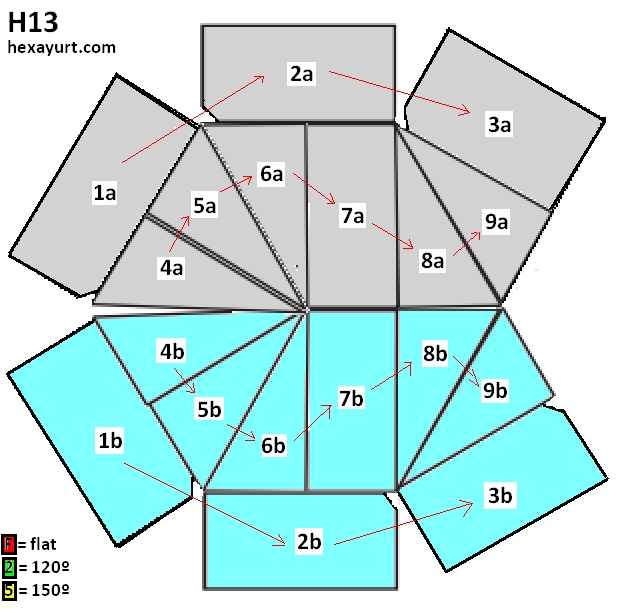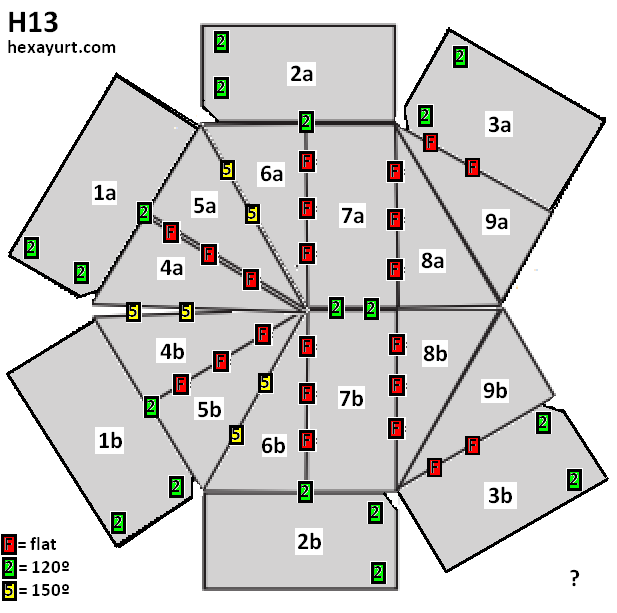No edit summary |
|||
| Line 1: | Line 1: | ||
[[Category:Hexayurt project]] | [[Category:Hexayurt project]] | ||
'''THIS PAGE IS CURRENTLY UNDER CONSTRUCTION, BASICALLY BECAUSE IT'S HARDER TO UNDERSTAND RELATIVE TO, SAY, A CARDBOARD MODEL :-P. SO, EXPECT MANY CHANGES. DON'T TRUST FOR BUILDING YET. CONTRIBUTE IF YOU CAN - MAYBE IN THE DISCUSSION/TALK PAGE? [[User:LucasG|LucasG]] 09:05, 27 July 2011 (PDT)''' | |||
== H13 Plywood == | == H13 Plywood == | ||
| Line 29: | Line 31: | ||
=== Cost === | === Cost === | ||
Very local, but let's say it's ... | |||
=== Naming the pieces === | === Naming the pieces === | ||
| Line 42: | Line 46: | ||
[[File:H13plywoodGrayWithBlocks.PNG]] | [[File:H13plywoodGrayWithBlocks.PNG]] | ||
=== Understand overlapping === | |||
Polyiso panels are used full size with no overlapping, but plywood is different. | |||
As for the normal roof cone - obey the normal order, until you get to panel 9. 9a and 9b both go *over* 3a and 3b, then 4a and 4b go over 9a and 9b. At the top, along the roof line, 3a-9a-4a extend over 3b-9b-4a. | |||
If the boards are trimmed, a little slot taken out of 9b and 4b, the whole thing should fit tightly at the roof line. The slot is analogous to the roof cone trimming. Let me try to explain. | |||
Basicaly, where 3a overlaps 3a, there's a section where the wood is two layers thick. 9b is pressed against 9a, but at that point of overlap, 3a gets in the way. 9b is trimmed so that 4a doesn't get in the way. You wind up cutting a piece the thickness of one piece of plywood, and as wide as that overlap, out of the top right corner of 9b so that 9b can fit tight against 9a, basically. | |||
This will probably make sense in a model if you overlap the pieces in the model. | |||
== Build it == | == Build it == | ||
Walls first, then the roof. | |||
=== Cut wood === | === Cut wood === | ||
Cut triangles, trim triangles, trim panels, cut Sri Lankan corners, cut blocks of different sizes. | |||
=== Make walls === | === Make walls === | ||
Use string to mark 6 corners. Maybe place blocks and make sure they are aligned with the horizontal plane, with communicating vessels? Then screw the "2" blocks for all 6 panels, and finally screw the walls together? | |||
=== Make roof === | === Make roof === | ||
The roof is built from the back forwards. | |||
Because we have the nice vertical boards, 5b goes in last, and can be screwed into place from the outside, so nobody is left stuck inside of the hexayurt in the same way as you get with the normal roof cone construction. This is very important and it's a much easier build because we don't have the same problems getting to the last two boards. | |||
When the roof is lifted and put on the walls, however, 5a/5b tends to fall over 8a/8b because, well, there's nothing to stop it! On the rest of the sides, the roof cannot fall past the walls because the roof is at an angle. But these two wall pieces are both vertical, so it falls straight past. I think the answer is to put an 8' high 2x4 piece '''inside''' the roof, wedged up against the point to hold it up while the walls are lined up, then screw 5b/8b and so on (ah, that will be 3 more flat blocks each), and then screw the 8' 2x4 piece of wood into the vertical part to hold the point of the roof stable. | |||
This is just my best guess, of course, we're going to need to build a few more before we're completely sure! But the key is that it's actually easier than the regular version. | |||
Also we haven't figured out the best way to do a door yet. | |||
=== Put roof on top === | === Put roof on top === | ||
Revision as of 16:05, 27 July 2011
THIS PAGE IS CURRENTLY UNDER CONSTRUCTION, BASICALLY BECAUSE IT'S HARDER TO UNDERSTAND RELATIVE TO, SAY, A CARDBOARD MODEL :-P. SO, EXPECT MANY CHANGES. DON'T TRUST FOR BUILDING YET. CONTRIBUTE IF YOU CAN - MAYBE IN THE DISCUSSION/TALK PAGE? LucasG 09:05, 27 July 2011 (PDT)
H13 Plywood
- Vinay Gupta invented the basic shape in 2003. The H13 was designed by Scott Davis and Dylan Toymaker (design published in November 2010). The H13 adds one panel to the “classic” H12 hexayurt, but that one extra sheet of plywood gets an 8′ roof line and 2-3 times the walkable space inside the hexayurt.
- The H13 has been built with polyiso panels and there's even a design to make it folding.
- This page describes the specificities for a H13 built with wood.
Links and videos
Before you start
Tools
- You need to cut 5 diagonals and XXX blocks. You need to do some trimming.
- You need to screw XXX about 200
Wood
- 13 panels of plywood or OSB3. Each is 4" by 8".
Screws
2" deck screws. Any head is fine. Non-countersinking screws are better because they don't weaken the plywood wood where the screw is by crushing it or cutting into it. XXX number.
"Wafer head" seems to be the name for these. But I've never found them locally, so I use regular deck screws!
Cost
Very local, but let's say it's ...
Naming the pieces
- A "panel" cut through the diagonal gives us 2 "triangles". Please refer to this chart to name the "panels" and "triangles". (By the way, you can use this chart to print it on paper, then cut and fold it, and just cello-tape the walls (1a to 2a to 3a to 3b to 2b to 1b to 1a).
- The "wall" has 6 "wall sides": 1a, 2a, 3a, 1b, 2b and 3b. Each has a small triangle cut off. The triangle is a rectangle triangle: measure 6 inches for each leg of the triangle, then cut through the hypothenuse. This is called the Sri Lankan corner, because it was invented in Sri Lanka (V has the details).
- The "wall sides" are joined together with 12 wooden blocks, 2 at each angle, which are made from 2"x4" wood, cut at a 120º angle.
- The "roof" has 2 "classic roof sides" (4a+5a and 4b+5b), 2 "big roof sides" (6a+7a and 6b+7b), and 2 "horizontal-vertical roof sides" (8a+9a and 8b+9b).
- There will be "blocks", cut off 2"x4" lumber: some are cut at 120º angle, others at 150º angle and others are used "flat". The following pictures shows MOST of the blocks right. Still looking at the video (above) to find out if some are wrong! Sorry, no high visual skills! LucasG 08:38, 27 July 2011 (PDT)
Understand overlapping
Polyiso panels are used full size with no overlapping, but plywood is different.
As for the normal roof cone - obey the normal order, until you get to panel 9. 9a and 9b both go *over* 3a and 3b, then 4a and 4b go over 9a and 9b. At the top, along the roof line, 3a-9a-4a extend over 3b-9b-4a.
If the boards are trimmed, a little slot taken out of 9b and 4b, the whole thing should fit tightly at the roof line. The slot is analogous to the roof cone trimming. Let me try to explain.
Basicaly, where 3a overlaps 3a, there's a section where the wood is two layers thick. 9b is pressed against 9a, but at that point of overlap, 3a gets in the way. 9b is trimmed so that 4a doesn't get in the way. You wind up cutting a piece the thickness of one piece of plywood, and as wide as that overlap, out of the top right corner of 9b so that 9b can fit tight against 9a, basically.
This will probably make sense in a model if you overlap the pieces in the model.
Build it
Walls first, then the roof.
Cut wood
Cut triangles, trim triangles, trim panels, cut Sri Lankan corners, cut blocks of different sizes.
Make walls
Use string to mark 6 corners. Maybe place blocks and make sure they are aligned with the horizontal plane, with communicating vessels? Then screw the "2" blocks for all 6 panels, and finally screw the walls together?
Make roof
The roof is built from the back forwards.
Because we have the nice vertical boards, 5b goes in last, and can be screwed into place from the outside, so nobody is left stuck inside of the hexayurt in the same way as you get with the normal roof cone construction. This is very important and it's a much easier build because we don't have the same problems getting to the last two boards.
When the roof is lifted and put on the walls, however, 5a/5b tends to fall over 8a/8b because, well, there's nothing to stop it! On the rest of the sides, the roof cannot fall past the walls because the roof is at an angle. But these two wall pieces are both vertical, so it falls straight past. I think the answer is to put an 8' high 2x4 piece inside the roof, wedged up against the point to hold it up while the walls are lined up, then screw 5b/8b and so on (ah, that will be 3 more flat blocks each), and then screw the 8' 2x4 piece of wood into the vertical part to hold the point of the roof stable.
This is just my best guess, of course, we're going to need to build a few more before we're completely sure! But the key is that it's actually easier than the regular version.
Also we haven't figured out the best way to do a door yet.
Put roof on top
Beyond the very basics
Door and windows
Insulation
Permanent H13 (ferrocement)
Toilet etc
Help improving the documentation
- raw footage
- pictures (from video)

